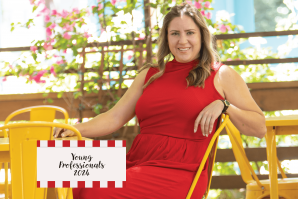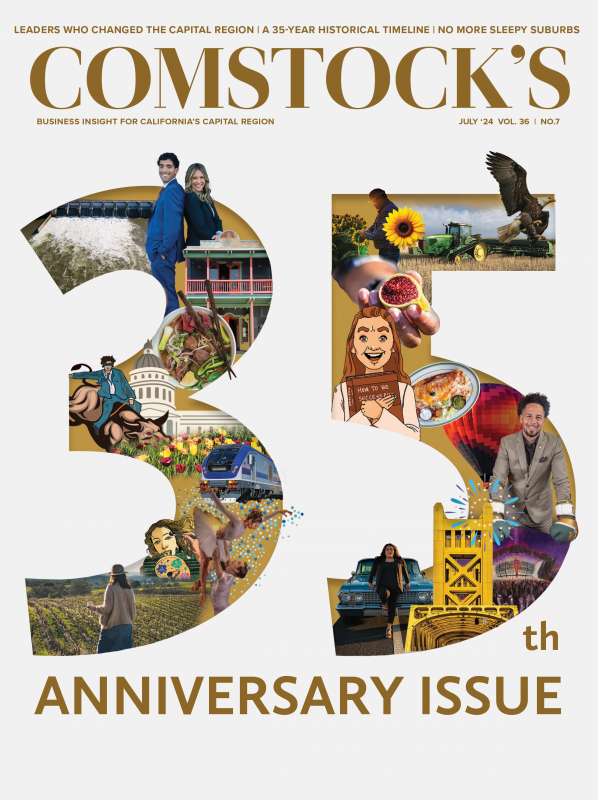In the last four years, Sacramento has seen a huge influx of new residents. Some came from the Bay Area during the pandemic — people who could work remotely and wanted more space at a more affordable price. Others came from around the country for similar reasons in the years since the end of the pandemic emergency, seeking a quieter, slightly slower-paced lifestyle, more proximity to the mountains, perhaps a bit more distance from the sometimes corrosive political battles and intimidating cost of living of the coastal cities.
Still more arrivals have come from overseas — Sacramento now has one of the country’s largest concentrations of Special Immigrant Visa holders from Afghanistan and refugees from Ukraine, as well as thousands of other immigrants and asylum-seekers from elsewhere in the world. In 2022 alone, upwards of 20,000 Ukrainians, fleeing Russia’s attack on their country, relocated to Sacramento and its environs.
Many of these new international arrivals end up in the community college system, beefing up their English language skills and studying for new qualifications that will allow them to work in their adopted country. “We try to get students into state-certified programs — six months to a year — so they can get a job,” explains Olga Prizhbilov, the soft-spoken director of refugee career pathways for the Los Rios Community College District. The district works with refugee resettlement agencies, such as the International Rescue Committee, to link up these newcomers with career development caseworkers, peer mentors and employers.
Just under 2.4 million people live in the Sacramento-Roseville-Folsom metropolitan area, an increase of roughly a quarter since the turn of the century. Of these, according to the Migration Policy Institute, 450,000 are immigrants. Of all the many hundreds of metropolitan statistical areas in the country, this region now has the 52nd highest concentration of immigrants.
While it is far behind Miami — which leads the country with 41.49 percent of its residents being immigrants — or Los Angeles, San Francisco, San Jose and New York, in all of which roughly one in three residents were born overseas, Sacramento’s influx is still high enough to have transformed entire communities in short periods of time. Go to the Arden Arcade area, for example, and one will find large numbers of Afghan and Syrian immigrants, along with food stores, restaurants and other businesses that have sprung up over the past few years to cater to their tastes and cultural preferences. To the south of the city, in the unincorporated area just north of Elk Grove, one can find similar concentrations of new arrivals. There are clusters of Ukrainians, Tigrayans, Venezuelans and many additional nationalities.
“We have a number of folks in our community here in Sacramento seeking asylum from Venezuela, Columbia, Guatemala, Mexico and El Salvador,” says Jessie Mabry, CEO of the non-profit refugee resettlement agency Opening Doors. There are also, she says, a smattering of asylum-seekers who crossed into California at or near the border with Tijuana, from China, Haiti and sub-Saharan Africa. It has, she explains, taken more than three years to rebuild the resettlement program — and the overseas screening processes — since it was dismantled during the 2017 to 2021 Trump presidency. As a result, now “we are just as busy in refugee resettlement as we were at the height of Afghan resettlement in 2021.”
Putting down roots
In a large, $2,200 per month, three-bedroom ranch house just north of Elk Grove’s city limits, 42-year-old Said Asadullah Sadaat lives with his wife and children, his two sisters and their kids. The 12 of them were part of a larger group of 32 people who in 2021 managed to flee Taliban-controlled Afghanistan to Iran and Pakistan. They then flew from there to Brazil (a country where they had managed to secure visas) and from Brazil took buses, short-hop planes and walked northward on what ended up becoming a 45-day journey north to the U.S. border.
Said Asadullah Sadaat and his family of 12 settled into a rental
home in Elk Grove after they fled Afghanistan in 2021. His wife,
Malika, daughter Saghar, son Elham and Sadaat with his infant
daughter Elhan.

They trekked the notorious Darién Gap in the Panama jungle and endured all the other hazards of the thousands-of-miles-long irregular migratory path. From Tijuana, he says, they took an overnight route over the mountains and into the U.S., where they surrendered themselves and promptly applied for asylum.
Sadaat’s group moved to Sacramento in the winter of 2022, drawn by his sister already living there and by an awareness that there was a large Afghan population in the city. This past December, their asylum claim was granted, and the members of the extended family are now studying English and looking for work. They receive food stamps and some cash assistance, but, Sadaat says, his bare feet impatiently tapping the floor beneath his coffee table, “I don’t want to stay in this situation. I want to find a job. I try every day.”
On the whole, Sadaat loves Sacramento, though, he admits sheepishly, at times he is overwhelmed by all of the choices, especially in supermarkets. “You want one thing, but you end up with 10 things,” he says. “Everything is in front of you. You think you’ll be in the market 10 minutes, but you spend an hour shopping. For us, it is new. In Afghanistan, everything is different. There are no stores that you go inside — everything is in front of the store. And everything involves bargaining. Here, everything is a fixed price, and there are a lot of items.”
Sadaat’s compatriot, 26-year-old onetime medical student Maryam Sulaimani, is also learning to navigate her new city. In 2022, she, her brother and her brother’s family fled Afghanistan after “universities were banned to every girl. It was a bad situation. Girls and women could not continue education and work.” They went first to a refugee camp in Abu Dhabi in the United Arab Emirates, then, when her refugee status was confirmed nearly a year later, she continued on to Virginia and then California.
Sulaimani is currently taking English as a second language classes at Cosumnes River College. For a while, she had a job at an Apple warehouse, but its hours conflicted with her studies, and she had to give it up. Now she’s looking for part-time employment. “Any kind of job,” she explains. “I need money.” She doesn’t know if she’ll have the resources to go to a U.S. medical school, but, at the very least, she hopes to be an ultrasound technician or a medical assistant.
The great Bay Area migration
It is not just the desperate and the displaced, however, who are making Sacramento their new home. Many far more affluent arrivals are also coming in, particularly from the Bay Area to the west and from the high real estate markets of Southern California. It’s that influx which is largely responsible for Redfin’s realty market analysis concluding that far more newcomers are looking to buy into the Sacramento housing market than is the case for any other urban center in the country.
All of this population expansion is making Sacramento a more dynamic metropolitan region than used to be the case even 10 years ago (and a place where Bay Area basketball fans sometimes outnumber locals at Kings-Warriors games). Its cafe, restaurant and bar scenes have been elevated, at least in part to cater to the desires of these affluent arrivals. But at the same time, it is also putting strong upward pressures on the already taut housing market, making it ever harder for longtime locals to find affordable accommodations. Median home prices have risen nearly 40 percent in Sacramento since the pre-pandemic days.
For 47-year-old John Jackson, his wife and two children, the pandemic catalyzed a move that they had spent years thinking about. At the time, Jackson was an elementary school principal, his wife a dental hygienist. They lived in the Walnut Creek area, and as the pandemic intensified, John found himself swamped by stress. “We were like, look, let’s move to an area that’s a little bit slower — not the country, but a little bit slower.”
With friends in El Dorado Hills whom they started visiting to escape the claustrophobia of pandemic living in the Bay Area, they eventually decided to make the move. At the same time, John, burned out by the COVID years, opted for a career switch, getting out of education and moving into real estate — his sister is a real estate agent, his father-in-law a loan broker, so he had familiarity with the profession.
Jackson set up shop as a realtor in El Dorado Hills and rapidly built up a clientele of people looking to move from the Bay Area into the Sacramento region. “This is a lovely place to raise your family,” he says simply. “The influx has been continuous over the last couple of years. Maybe right after the pandemic was the spike of it, but it’s very consistent.”
Take, for example, Stephanie Hanson, who spent her childhood moving back and forth between Sacramento and the Bay Area and ended up living in what she says was a “tiny little house” in Pleasanton. During the pandemic, her mother, who is in her 90s, moved in with her, as did her two adult children. Eventually, Stephanie had enough of the overcrowding. Her elder sister had lived in El Dorado Hills since the late 1980s, and now Stephanie decided it was time to join her. “It just made so much sense for the family, so that’s what we did. We moved two years ago, March, and I love it. I love it so much. I found so many positives. The bigger house is great, and being close to family. I love being closer to Lake Tahoe and more mountains and trails.”
Through a local Facebook page, Stephanie has found a group to hike with. She has also, she says, started to decompress from the stresses and the tensions of the Bay Area. “I just kind of felt instantly at home. Found restaurants we liked, great dry cleaners. No regrets.”
It is a story heard time and again these days in the Sacramento region.
For 64-year-old Jaime Flores, a retired program manager for a software company, the move away from San Jose and toward the Capital Region was all about getting real estate that was less expensive and more spacious than what he and his wife could afford in the Bay Area. They moved from a small house to a large place in El Dorado Hills, 1,900 square feet, with high ceilings and an outdoor pool; and now, he says, can take advantage of the area’s dry summer heat.
For Ben Ben-Aderet, an Israeli immigrant and co-founder of GRSee Consulting, a cybersecurity security firm, his wife and their two middle school aged kids, the move from Sunnyville east was also about gaining space. They went from paying $5,400 a month in rent for a mid-sized house to buying a 3,400 square-foot home. His son complains that things aren’t as diverse here as in the Bay, but, says Ben-Aderet, “overall, we’re pretty happy with the move, all of us.” And, he adds, now that they’re out of the Bay, his kids aren’t in a continuous competition with their peers over status symbols and signs of wealth in their lives; they don’t feel “that there is always someone who has more than you do.”
The influx of newcomers into the Capital Region shows no signs of slowing. By the year, it is becoming more ethnically and culturally diverse. And by the year, too, it is inexorably being drawn into the greater Bay Area megaregion; its real estate market increasingly beholden to Bay Area emigres looking to make their housing dollars go further.
“The weather is OK,” says Said Asadullah Sadaat of his new home. “The people is good. Very quiet. The roads are not too busy. For us, Sacramento is the best.”
Get all the profiles in our Young Professionals issue delivered to your inbox: Subscribe to the Comstock’s newsletter today!
Recommended For You

Building the Future
Veteran architects are essential in mentoring young, emerging designers
The field of architecture is changing, and technology is playing a central role, but it’s not the only element that’s shifting: so is the expectation of what young and emerging professionals are looking for in an architectural job.

Young Professionals: Katie Hanten
Meet the emerging leaders who envision a bright future for the Capital Region
In 2021, Katie Hanten founded her full-service design and development firm — Vertical Pacific — through which she’s helping evolve the city’s urban core.

Young Professionals: Jacob Gutierrez-Montoya
Meet the emerging leaders who envision a bright future for the Capital Region
Jacob Gutierrez-Montoya founded Sacramento Contemporary Dance Theatre, whose mission is to translate the work of local nonprofits into art.

Young Professionals: Kevin Dobson
Meet the emerging leaders who envision a bright future for the Capital Region
Kevin Dobson is founder and executive director of Capital College & Career Academy, a public charter high school that trains teenagers to work in construction.

Some Important Bedfellows: Financial Literacy, Art, Reading and Writing
Comstock’s President and Publisher Winnie Comstock-Carlson examines the shortcomings of California’s public school system.

Young Professionals: Jade Rodgers
Meet the 10 young professionals who are rocking it in their careers and community
When it comes to navigating life and work, 916 Ink’s Jade Rodgers is a firm believer in “ubuntu,” an African word meaning “my humanity is tied to yours.” “Our experience in this life is interconnected,” she says.




